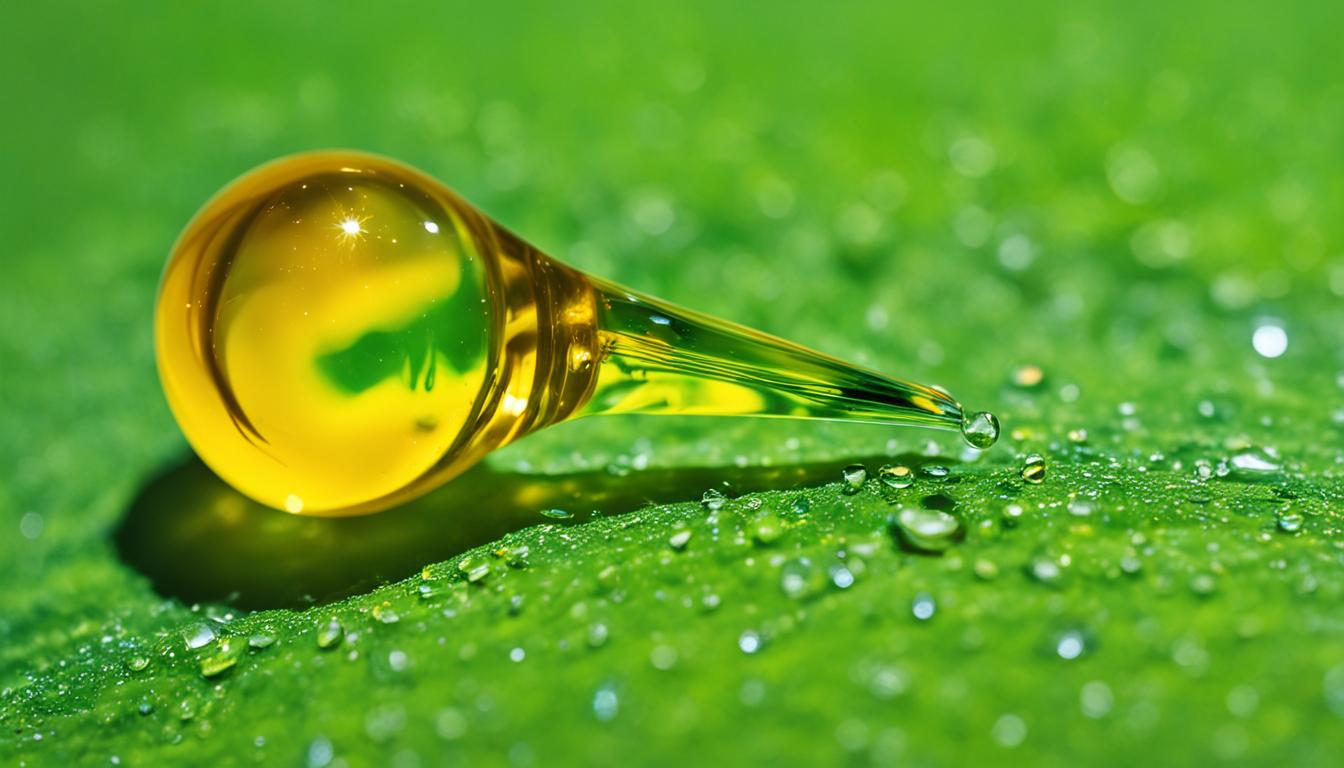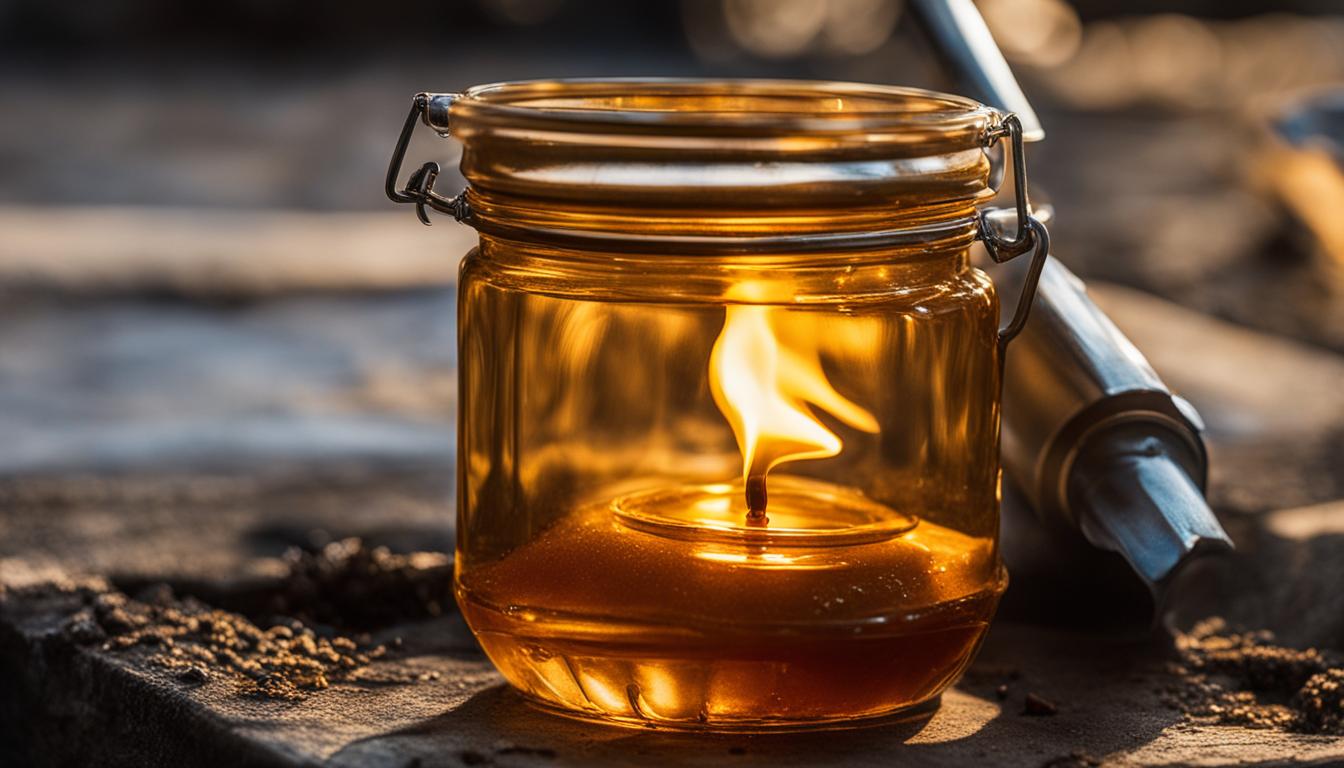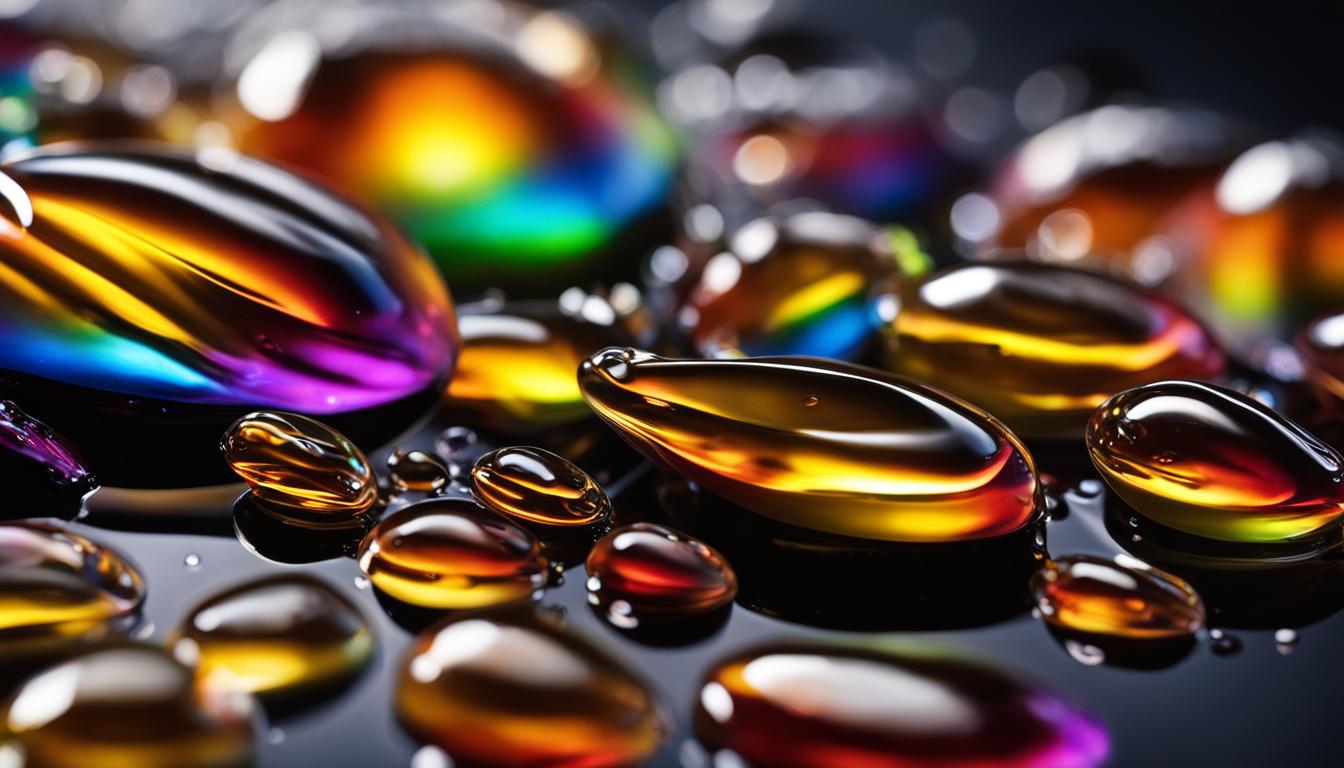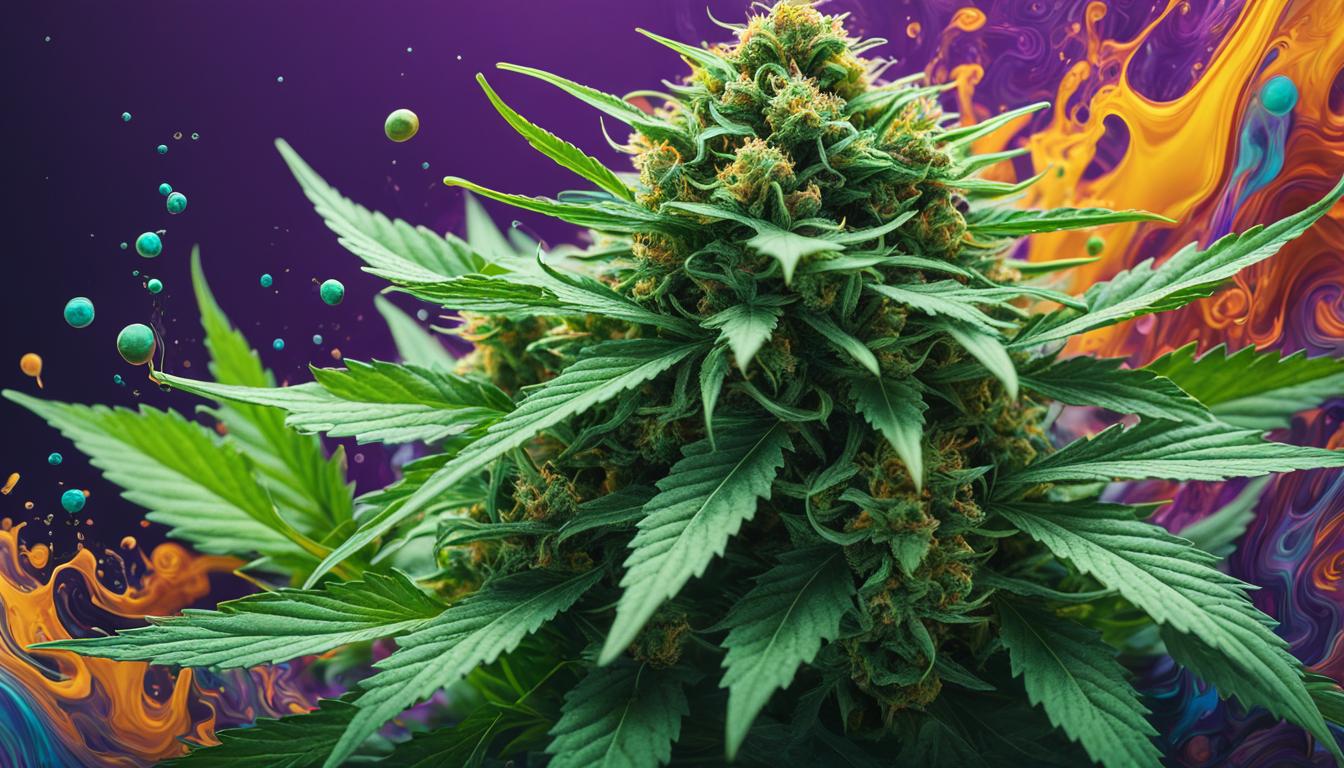Uncategorized
Melt Cannabis: Ultimate Guide to Liquid THC Products
Hello, cannabis enthusiasts! If you’ve ever wondered how to transform your cannabis into versatile liquid THC products, you’ve come to the right place. In this comprehensive guide, I will walk you through the melting process, techniques, and tips to help you unlock the secrets of liquid THC and take your cannabis experience to a whole new level.
Key Takeaways:
- Learn the melting techniques and temperatures for cannabis extraction.
- Discover the melting points of cannabis and how it affects the final product.
- Get insider tips on melting cannabis for edibles, dabbing, or vape pen cartridges.
- Explore the different textures and consistencies of cannabis concentrates.
- Understand the importance of safety precautions when working with solvents.
What are Solvent Extracts?
Solvent extracts are a popular method of extracting the resin from cannabis. This process involves using various solvents to dissolve the trichome heads and separate them from the plant material. Solvents can be divided into polar and non-polar categories, each with different extraction capabilities. Solvent extracts can produce a wide range of products, including:
- BHO (Butane Honey Oil)
- Live Resin
- Terp Sauce
- PHO (Propane Honey Oil)
- Dewaxed Extracts
- QWET (Quick Wash Ethanol)
- Dimethyl Ether
- CO2 Oil
- Solvent-free concentrates like distillates and isolates
In the extraction process, solvents like butane, propane, ethanol, and CO2 are used to dissolve the trichome heads, which contain the desired cannabinoids and terpenes. These solvents efficiently separate the trichomes from the plant material, resulting in concentrates with high levels of cannabinoids and terpenes.
Here is a breakdown of some popular solvent extracts:
BHO (Butane Honey Oil)
Butane Honey Oil, or BHO, is created by dissolving resin in butane and purging it under vacuum to remove the gas. This process results in a high-purity cannabis concentrate that comes in different textures, including shatter, budder, sugar wax, and wax. BHO concentrates are known for their high THC content and can deliver a potent experience.
Live Resin
Live resin is a type of BHO that is extracted from freshly cut, flash-frozen buds. This extraction method preserves the plant’s terpenes, resulting in a concentrate with a sticky, syrupy texture and a rich flavor profile. Live resin is highly sought after for its aromatic and flavorful experience.
Terp Sauce
Terp sauce, also known as High Terpene Full Spectrum Extract (HTFSE) and High Cannabinoid Full Spectrum Extract (HCFSE), is a concentrate with a high terpene content. It is produced through a long, slow, and low vacuum purge at low temperatures. Terp sauce is known for its runny honey-like consistency with crystals and offers a complete and flavorful cannabis experience.
PHO (Propane Honey Oil)
Propane Honey Oil, or PHO, is similar to BHO but made by dissolving resin in propane instead of butane. PHO extracts slightly different ratios of cannabinoids and waxes, resulting in concentrates with a budder or wax-like texture. PHO is popular among consumers who prefer terpene-rich concentrates.
Dewaxed Extracts
Dewaxed extracts aim to remove non-active ingredients like waxes and lipids from the cannabis resin. Winterization is a traditional dewaxing process that uses cold filtering with secondary solvents like ethanol. However, this process can reduce the terpene content. Nowadays, column dewaxing during the initial butane extraction preserves the terpenes at lower temperatures, resulting in cleaner and more flavorful BHO.
QWET (Quick Wash Ethanol)
QWET, or Quick Wash Ethanol, is an alcohol-based extraction method that can be done at home. Ethanol is used to dissolve cannabis resin, producing high-purity extracts suitable for dabbing or smoking. The duration of the wash can affect the extract’s consistency, with longer soaks resulting in darker and more viscous oils. QWET extracts are commonly used for oral consumption and topical applications.
Dimethyl Ether
Dimethyl Ether (DME) is a solvent that has gained attention as a potentially safer alternative to butane for cannabis extractions. DME extraction results in high-purity extracts with increased cannabinoid and terpene content. However, DME is less popular among professional extractors and less commonly available in dispensaries.
CO2 Oil
CO2 oil is a widely used solvent extract created through carbon dioxide extraction. It produces a clean and residual-free concentrate, making it a popular choice for edibles and vape pen cartridges. However, CO2 extraction may lead to the loss of some terpenes, resulting in a less distinct flavor profile.
BHO: Experience the Different Textures of Butane Honey Oil
As a cannabis enthusiast, you may have come across the term BHO, which stands for Butane Honey Oil. This popular solvent extract is cherished for its high-purity cannabis concentrate. The process involves dissolving resin in butane and purging it under vacuum to eliminate all the gas. The result? A concentrate that offers a potent and flavorful cannabis experience.
BHO can manifest in various textures, each with its own unique qualities. Let’s explore these different textures of BHO and understand how they influence your consumption:
- Shatter: Known for its glass-like consistency, shatter contains high levels of THC and minimal terpenes, making it an ideal choice for those seeking a powerful, clean high.
- Budder: With a smooth and creamy texture, budder offers a balance between THC potency and terpene profiles. Its malleability allows for easy handling and dabbing.
- Sugar Wax: This crumbly and granular texture is created by allowing the concentrate to crystallize during the extraction process. Sugar wax delivers intense flavors and potent effects.
- Wax: Wax, also referred to as “earwax” or “honeycomb,” has a soft and pliable consistency. It retains a significant amount of terpenes, resulting in a rich aroma and enhanced flavor.
Unlocking the Secrets of BHO
The texture of BHO is influenced by several factors, including the genetics of the cannabis strain, the terpene content, and the techniques used during the purging process. By mastering these elements, extractors can create concentrates that cater to different preferences and desired effects.
Now that you have a deeper understanding of BHO and its remarkable textures, you can explore the world of cannabis concentrates with confidence. Whether you’re looking for a potent hit of THC or a flavorful dabbing experience, BHO in its various forms has you covered.
Remember, enjoy BHO responsibly and always prioritize safety when handling cannabis concentrates!
Live Resin
When it comes to cannabis concentrates, one form that has gained immense popularity is live resin. Extracted from freshly cut, flash-frozen buds, live resin captures the true essence of the live plant. What sets live resin apart is its sticky, syrupy texture, thanks to the high terpene content. Terpenes are the aromatic compounds responsible for the flavors and smells in cannabis.
Creating live resin requires careful handling of the plant material to retain the freshness and potency of the terpenes. The buds are frozen immediately after harvest, preserving their terpene profile. This freezing process helps to prevent the degradation of terpenes, ensuring a flavorful concentrate.
Due to its high terpene content, live resin offers a robust and complex flavor profile. Whether you prefer fruity, citrusy, or earthy tastes, live resin provides a wide range of aromatic experiences. The potency of live resin is also noteworthy, as it boasts high levels of THC, the psychoactive compound responsible for the euphoric effects of cannabis.
For those looking to elevate their cannabis experience, live resin is a top choice. Its rich terpene content and sticky consistency make it perfect for dabbing, providing intense flavors and effects. Additionally, live resin can be used to enhance the flavor and potency of other cannabis products, such as edibles or vape cartridges.
In summary, live resin is a highly sought-after cannabis concentrate known for its sticky texture and high terpene content. By carefully extracting from flash-frozen buds, live resin captures the full range of flavors and aromas, resulting in a flavorful and potent concentrate that can enhance any cannabis experience.

Terp Sauce or HTFSE & HCFSE
Terp sauce, also known as High Terpene Full Spectrum Extract (HTFSE) and High Cannabinoid Full Spectrum Extract (HCFSE), is a recent trend in concentrates. These extracts have extremely high terpene content achieved through a long, slow, and low vacuum purge at low temperatures. HTFSE contains between 13% to 25% terpenes and has a runny honey-like consistency with crystals, while HCFSE has a THC-A content of around 90% and appears as diamonds coated in sauce. Both offer a more complete and flavorful cannabis experience.
If you’re looking for a concentrate that packs a powerful punch and bursts with flavor, terp sauce is the way to go. These extracts are created through a meticulous extraction process that focuses on terpene preservation, resulting in a product that showcases the full range of aromatic compounds found in the cannabis plant.
One of the key advantages of terp sauce is its high terpene content. Terpenes are organic compounds responsible for the distinct aromas and flavors of cannabis strains. They also interact with cannabinoids like THC and CBD, influencing the overall effects and therapeutic properties of the concentrate.
The unique extraction process used to produce terp sauce involves extracting the resin from the cannabis plant while maintaining low temperatures and a careful vacuum purge. This slow and precise process allows for the preservation of a wide range of terpenes, resulting in a concentrate that captures the essence of the original plant material.
Benefits of Terp Sauce:
- Intense flavor profile: Terp sauce is known for its incredible aromatic and taste properties, allowing users to experience a more flavorful and enjoyable cannabis experience.
- Potent effects: With a high terpene content, terp sauce offers a more comprehensive range of effects, enhancing the overall potency and therapeutic potential of the concentrate.
- Versatile uses: Terp sauce can be used in various ways, including dabbing, vaping, and incorporating it into edibles or topicals for a potent and flavorful cannabis-infused product.
- Craftsmanship: The production of terp sauce requires a skillful and meticulous process, resulting in a premium concentrate that showcases the artistry and expertise of the extractor.
Whether you’re a connoisseur seeking an extraordinary flavor experience or a medical user looking for a potent and versatile cannabis concentrate, terp sauce, HTFSE, and HCFSE are excellent choices. These extracts allow you to enjoy the full spectrum of terpenes and cannabinoids for a truly remarkable cannabis experience.
PHO or Propane Honey Oil
Propane Honey Oil (PHO) provides a unique alternative to the more common Butane Honey Oil (BHO) extraction method. While BHO uses butane as the solvent, PHO involves dissolving cannabis resin in propane. This change in solvent results in slightly different ratios of cannabinoids and waxes, giving PHO its distinctive characteristics.
One notable difference between PHO and BHO is the texture of the final concentrate. PHO often produces a budder or wax-like consistency, which can be appealing to many cannabis consumers. The variation in texture is attributed to the specific composition of the cannabinoids and waxes extracted using propane as the solvent.
Another advantage of PHO is the lower boiling point of propane compared to butane. This lower boiling point allows for easier purging during the extraction process. Purging involves removing any residual solvent from the concentrate, ensuring a clean and safe final product. With PHO, the lower boiling point of propane makes purging more manageable without jeopardizing the delicate terpene profile of the concentrate.
In summary, PHO is a less common extraction method that utilizes propane as the solvent. This alternative to BHO offers a unique texture, often resembling budder or wax, and allows for easier purging without compromising the terpene content. If you’re seeking a terpene-rich concentrate with a distinct consistency, PHO is worth exploring.

Benefits of PHO:
- Unique budder or wax-like texture
- Easier purging process
- Preserves delicate terpene profile
Dewaxed Extracts
Dewaxed extracts play a crucial role in producing cleaner and more refined cannabis concentrates. By removing non-active components like waxes and lipids from the cannabis resin, extractors can create concentrates that offer enhanced purity and a smoother experience. Two common methods used for dewaxing include winterisation and column dewaxing.
Winterisation
Winterisation is a traditional dewaxing process that involves using a secondary solvent, usually ethanol, to dissolve the cannabis resin. The mixture is then placed in a cold environment for an extended period, typically overnight. The cold temperature causes the waxes and lipids to solidify, allowing them to be filtered out.

Note: The image above illustrates the process of dewaxed extracts.
While winterisation effectively removes waxes, it also has a downside. The extraction process can result in the loss of some terpenes, which are responsible for the aroma and flavor of the cannabis. This can lead to a less flavorful final product.
Column Dewaxing
Column dewaxing is an alternative method that has gained popularity among extractors. This technique involves incorporating dewaxing steps during the initial butane extraction process. By utilizing lower temperatures, typically below -20°C (-4°F), column dewaxing aims to keep the terpenes intact while removing a significant amount of waxes.
The column dewaxing process begins with freezing the extraction column and the solvent, such as butane, to sub-zero temperatures. During extraction, the cold temperature causes the waxes to solidify and accumulate on the filtration media (typically stainless steel screens or filter paper). This allows the terpene-rich solvent to pass through, leaving behind a cleaner and more flavorful concentrate.
Avoiding the loss of terpenes is essential in producing concentrates with robust flavors and aromatic profiles. Column dewaxing strikes a balance between preserving terpenes and removing waxes, resulting in a clean and flavorful BHO (Butane Honey Oil).
Comparing Winterisation and Column Dewaxing
| Process | Pros | Cons |
|---|---|---|
| Winterisation |
|
|
| Column Dewaxing |
|
|
Table: A comparison of winterisation and column dewaxing methods
While winterisation remains a valid dewaxing option, column dewaxing offers a more advanced approach that prioritizes the preservation of terpenes while still achieving desirable levels of dewaxing. Extractors can select the method that best suits their specific requirements and desired end product.
QWET/QWISO
When it comes to homemade concentrates, QWET (Quick Wash Ethanol) and QWISO (Quick Wash Iso) are two popular solvent-based extraction methods. These techniques utilize alcohol to extract cannabinoids and produce potent concentrates that can be enjoyed through dabbing or smoking.
One of the preferred alcohols for these extractions is ethanol. It is easily accessible and has low flammability, making it a safe choice for DIY enthusiasts. The process involves soaking the cannabis in alcohol for a short duration. Short washes result in high-purity extracts with rich cannabinoid profiles.
The length of the wash determines the composition of the final product. Longer soaking times will extract additional compounds like waxes and chlorophyll, resulting in a darker and more viscous oil. These extracts are commonly used for oral consumption and topical applications by therapeutic patients.
Here is a summary of the QWET/QWISO extraction process:
- Select high-quality cannabis material.
- Grind the material to increase surface area.
- Place the ground cannabis in a jar or container.
- Add the alcohol (ethanol) to the jar, ensuring the material is fully covered.
- Gently agitate the mixture for a short duration.
- Strain the liquid using a fine mesh or cheesecloth to remove plant material.
- Allow the extracted liquid to evaporate in a safe, well-ventilated area.
- The result is a concentrated oil suitable for various consumption methods.
It’s important to note that working with alcohol can be dangerous, and proper safety precautions should be followed. Ensure proper ventilation, use appropriate equipment, and avoid any open flames or sparks during the extraction process.
“QWET and QWISO provide a convenient way to make homemade cannabis concentrates. It allows DIY enthusiasts to produce potent extracts using alcohol as a solvent. However, safety precautions should always be a top priority.”
With just a few simple steps, you can create your own QWET or QWISO concentrates at home. Experiment with different strains and soaking times to find the perfect balance of potency and flavor. Just remember to always consume responsibly and in compliance with local laws and regulations.
Dimethyl Ether/MZ12X/Dexso/DME
In the world of cannabis extractions, Dimethyl Ether (DME) has emerged as a potential alternative to butane, offering advantages in terms of safety and extraction quality. Manufacturers claim that DME boasts high purity, low toxicity, and reduced flammability, making it a promising solvent choice for cannabis extraction.
Compared to butane, DME can extract a broader range of compounds from the cannabis plant, resulting in concentrates with higher levels of cannabinoids and terpenes. This enhanced extraction capability can lead to more potent and flavorful extracts that captivate the senses.
However, it is important to note that DME extraction is not as prevalent among professional extractors and may be less commonly available in dispensaries compared to other solvents. While it shows promise, its adoption may vary in different regions.
The Benefits of Dimethyl Ether (DME) Extraction
- Higher purity: DME extraction can yield extracts with exceptional purity levels, ensuring a clean and enjoyable cannabis experience.
- Increased cannabinoid and terpene content: DME is capable of extracting a wider range of compounds, resulting in concentrates with higher levels of cannabinoids and terpenes.
- Improved safety profile: Manufacturers tout DME as a safer alternative to conventional solvents, emphasizing its low toxicity and reduced flammability. However, it is essential to adhere to strict safety precautions when working with any flammable solvent to mitigate potential risks.
When incorporating DME into your extraction process, always prioritize safety precautions. Ensure proper ventilation, use appropriate protective equipment, and follow established guidelines to safeguard against accidents or mishaps. It is crucial to stay informed about the latest safety protocols and make responsible decisions when handling flammable solvents.
By understanding the potential benefits and safety considerations associated with DME extraction, you can make informed decisions regarding your cannabis extraction methods. Remember to prioritize safety, adhere to best practices, and experiment responsibly to produce high-quality extracts that elevate the cannabis experience.

CO2 Oil
CO2 oil is a widely used method in professional laboratories for cannabis extraction. It involves extracting the resin with carbon dioxide, resulting in one of the cleanest and most residual-free solvent extracts. CO2 oil is safer than BHO due to the absence of flammable solvents. However, CO2 extraction often leads to the loss of terpenes, resulting in a less distinct flavor profile. Despite this, CO2 oil is commonly used in edible products and vape pen cartridges, making it one of the most popular ways to consume cannabis concentrates.
When it comes to cannabis extraction, CO2 oil is considered one of the cleanest extracts available. The carbon dioxide extraction method safely and efficiently separates the resin from the plant material, resulting in a high-quality concentrate with minimal impurities or residual solvents. This makes CO2 oil a top choice for those who prioritize purity and cleanliness in their cannabis consumption.
Although CO2 oil may lack some of the distinctive flavors and aromas found in other types of concentrates, it more than makes up for it with its clean and potent effects. The absence of flammable solvents in the extraction process ensures a safer product for both producers and consumers. This is especially important when considering the use of CO2 oil in edible products, where safety and consistency are paramount.
Moreover, CO2 oil is also a favored choice for vape pen cartridges. The clean and pure nature of CO2-extracted oil allows for a smooth vaping experience without any unwanted residual flavors or harshness. Vape pen cartridges filled with CO2 oil provide a convenient and discreet way to consume cannabis concentrates on-the-go.
Overall, CO2 oil offers a reliable and efficient method of cannabis extraction, producing some of the cleanest and safest extracts available. Whether for use in edibles or vape pen cartridges, CO2 oil provides consumers with a high-quality product that delivers potent effects while maintaining a focus on purity and cleanliness.
Conclusion
In conclusion, this comprehensive guide provides valuable insights into melting cannabis for the creation of liquid THC products. By exploring various solvent and non-solvent extraction techniques such as BHO, live resin, terp sauce, and dewaxed extracts, you can unleash the full potential of cannabis concentrates. Additionally, we have discussed homemade extraction methods like QWET and QWISO, offering an accessible approach for cannabis enthusiasts.
Throughout this guide, we have emphasized the importance of safety precautions when working with solvents like butane and propane. It is crucial to prioritize your well-being by following proper procedures and guidelines.
By following the techniques and tips outlined in this guide, you can confidently embark on your journey to create high-quality cannabis concentrates. Whether you intend to infuse them into edibles, enjoy a dabbing experience, or use them in vape pen cartridges, this guide provides the knowledge you need to unlock the full potential of melted cannabis and liquid THC products.
FAQ
What are solvent extracts?
Solvent extracts are cannabis concentrates that are produced by using solvents like butane, propane, ethanol, and CO2 to dissolve the trichome heads and separate them from the plant material. They can include BHO, live resin, terp sauce, PHO, dewaxed extracts, QWET, Dimethyl Ether, CO2 oil, and solvent-free concentrates like distillates and isolates.
What is BHO (Butane Honey Oil)?
BHO, short for Butane Honey Oil, is a popular cannabis concentrate made by dissolving resin in butane and purging it under vacuum to remove all the gas. BHO can have different textures like shatter, budder, sugar wax, and wax, depending on factors like genetics, terpene content, and purging techniques.
What is live resin?
Live resin is a form of BHO that is extracted from freshly cut, flash-frozen buds. It captures the true essence of the live plant and is known for its sticky, syrupy texture due to the high terpene content.
What is terp sauce or HTFSE & HCFSE?
Terp sauce, also known as High Terpene Full Spectrum Extract (HTFSE) and High Cannabinoid Full Spectrum Extract (HCFSE), is a popular trend in cannabis concentrates. These extracts have extremely high terpene content achieved through a long, slow, and low vacuum purge at low temperatures. HTFSE contains between 13% to 25% terpenes and has a runny honey-like consistency with crystals, while HCFSE has a THC-A content of around 90% and appears as diamonds coated in sauce.
What is PHO or Propane Honey Oil?
PHO, or Propane Honey Oil, is a cannabis concentrate made by dissolving resin in propane instead of butane. The lower boiling point of propane allows for easier purging without affecting the terpenes, resulting in a concentrate with a budder or wax-like texture.
What are dewaxed extracts?
Dewaxed extracts aim to remove non-active ingredients like waxes and lipids present in cannabis resin to produce cleaner concentrates. Winterisation is a traditional dewaxing process that uses a secondary solvent like ethanol and cold filtering. Nowadays, extractors opt for column dewaxing during the initial butane extraction process to preserve terpenes at lower temperatures, resulting in a clean and flavorful BHO.
What are QWET and QWISO?
QWET (Quick Wash Ethanol) and QWISO (Quick Wash Iso) are solvent-based concentrates that can be made at home using alcohol. Ethanol is the recommended alcohol due to its low flammability and accessibility. Short washes produce high-purity cannabinoid-rich extracts suitable for dabbing or smoking. The longer the cannabis is soaked in alcohol, the more compounds like waxes and chlorophyll are extracted, resulting in a darker and viscous oil.
What is Dimethyl Ether/MZ12X/Dexso/DME?
Dimethyl Ether (DME) is a solvent that has gained attention as a potentially safer alternative to butane for cannabis extractions. Manufactured under various brand names like MZ12X and Dexso, DME claims to have high purity, low toxicity, and reduced flammability. It extracts a broader range of compounds than butane, resulting in extracts with higher cannabinoid and terpene content.
What is CO2 oil?
CO2 oil is a widely used method in professional laboratories for cannabis extraction. It involves extracting the resin with carbon dioxide, resulting in one of the cleanest and most residual-free solvent extracts. CO2 oil is safer than BHO due to the absence of flammable solvents. However, the CO2 extraction process often leads to the loss of terpenes, resulting in a less distinct flavor profile. CO2 oil is commonly used in edible products and vape pen cartridges, making it one of the most popular ways to consume cannabis concentrates.

